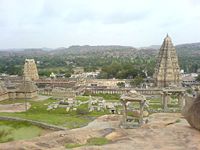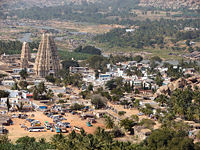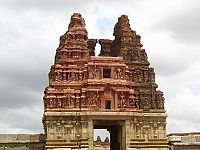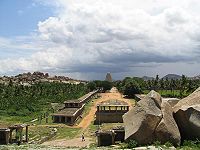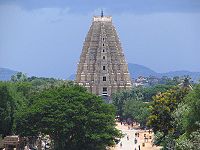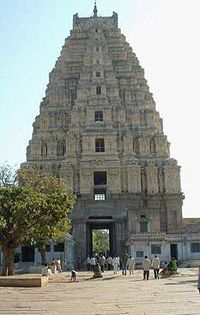Difference between revisions of "Hampi" - New World Encyclopedia
Dan Davies (talk | contribs) |
Rosie Tanabe (talk | contribs) |
||
| (15 intermediate revisions by 7 users not shown) | |||
| Line 1: | Line 1: | ||
| − | {{images OK}}{{ | + | {{approved}}{{submitted}}{{images OK}}{{Paid}}{{copyedited}} |
{{Infobox World Heritage Site | {{Infobox World Heritage Site | ||
| WHS = Group of Monuments at Hampi | | WHS = Group of Monuments at Hampi | ||
| Line 13: | Line 13: | ||
}} | }} | ||
| − | '''Hampi''' ([[Kannada]]: ಹಂಪೆ, ''Hampe'' | + | '''Hampi''' ([[Kannada]]: ಹಂಪೆ, ''Hampe'') refers to a village in northern [[Karnataka]]. <!--the name constitutes a corruption of Pampa, the puranic name of the [[Tungabhadra River]] on the banks of which the city stands.—> The name "Hampi" comes from the anglicized version of the Kannada ''Hampe'' (derived from ''Pampa,'' the ancient name for the Tungabhadra river). Over the years, it has also been referred to as Vijayanagara and Virupakshapura (from ''Virupaksha,'' the patron deity of the Vijayanagara rulers). |
| − | + | {{toc}} | |
| − | Hampi, located within the ruins of [[Vijayanagara]], served as the capital of the [[Vijayanagara | + | Hampi, located within the ruins of [[Vijayanagara]], served as the capital of the [[Vijayanagara Empire]]. Possibly predating the city of Vijayanagara, the village continues as an important religious center, housing the [[Virupaksha Temple]]. The village of Hampi contains several other monuments belonging to the old city. It extends into some of the old ceremonial streets of Vijayanagara. |
| − | Standing at the original center of Vijayanagara, people sometimes confuse the village with this ruined city. Hampi also goes by the name "The City of Ruins" | + | Standing at the original center of Vijayanagara, people sometimes confuse the village with this ruined city. Hampi also goes by the name "The City of Ruins." [[UNESCO]] has designated the Vijayanagara ruins as a [[World Heritage Site]] within the ''Group of Monuments at Hampi'' title.<ref>UNESCO, [http://whc.unesco.org/en/list/241 Group of Monuments at Hampi.] Retrieved December 20, 2006.</ref> |
| − | |||
| − | |||
| − | |||
| − | |||
| − | |||
==History== | ==History== | ||
| Line 28: | Line 23: | ||
<!-- Unsourced image removed: [[Image:Musical_Hall_Temple_Hampi.jpg|left|thumb|150px|Music Stage]] —> | <!-- Unsourced image removed: [[Image:Musical_Hall_Temple_Hampi.jpg|left|thumb|150px|Music Stage]] —> | ||
<!-- Not at right place: [[Image:Hampi_by_sourabh_by_indians.jpg|thumb|right|200px|Virupaksha Temple, Hampi]]—> | <!-- Not at right place: [[Image:Hampi_by_sourabh_by_indians.jpg|thumb|right|200px|Virupaksha Temple, Hampi]]—> | ||
| − | Hampi identifies with the mythological [[Kishkindha Kingdom|Kishkindha]], the [[Vanara]] (monkey) kingdom which finds mention in the [[Ramayana]]. The first historical settlements in Hampi date to 1 [[Common Era| | + | Hampi identifies with the mythological [[Kishkindha Kingdom|Kishkindha]], the [[Vanara]] (monkey) kingdom which finds mention in the [[Ramayana]]. The first historical settlements in Hampi date to 1 [[Common Era|C.E]]. Hampi formed one of the centers of the capital of the [[Vijayanagara Empire]] from 1336 to 1565. Muslim emperors destroyed it. The founders of Hampi selected the site for its strategic location, bounded by the torrential [[Tungabhadra river]] on one side and surrounded by defensible hills on the other three sides. |
| − | In terms of architecture and history, the site has immense significance. Abundant large stones had been used to create life like statues of gods. Structure of historic importance stand every quarter of a mile. Sadly the city stands in ruins, a testimony to the [[Islamic]] ravages of the sites. The conquerers considered the statues at Hampi idols, destroying or damaging all of them. Successive governments have been unable to protect the site from looters and treasure hunters who further | + | In terms of architecture and history, the site has immense significance. Abundant large stones had been used to create life-like statues of gods. Structure of historic importance stand every quarter of a mile. Sadly, the city stands in ruins, a testimony to the [[Islamic]] ravages of the sites. The conquerers considered the statues at Hampi idols, destroying or damaging all of them. Successive governments have been unable to protect the site from looters and treasure hunters, who cause further damage. The [[Archaeological Survey of India]] has conducted continuous excavations of the site to discover more artifacts and temples. |
==Geography== | ==Geography== | ||
[[Image:Hampi-Old-And-New.jpg|thumb|right|200px|Hampi overview]] | [[Image:Hampi-Old-And-New.jpg|thumb|right|200px|Hampi overview]] | ||
| − | Hampi sits on the banks of the Tungabhadra river, 353 km from [[Bangalore]], 254 km from [[Bijapur, Karnataka|Bijapur]] and 74 km away from [[Bellary]]. [[Hospet]], the nearest [[taluka]] headquarters, sits 13 km away. The majority of the people speak Kannada. Agriculture, the support of the Virupaksha temple and other holy places in the vicinity, and [[tourism]] represent the principal pillars of the village's economy. The | + | Hampi sits on the banks of the Tungabhadra river, 353 km from [[Bangalore]], 254 km from [[Bijapur, Karnataka|Bijapur]], and 74 km away from [[Bellary]]. [[Hospet]], the nearest [[taluka]] headquarters, sits 13 km away. The majority of the people speak Kannada. Agriculture, the support of the Virupaksha temple and other holy places in the vicinity, and [[tourism]] represent the principal pillars of the village's economy. The government of Karnataka organizes the annual Vijayanagar Festival in November. Mining rich deposits of [[iron-ore]] and [[manganese]] provides work and brings money into the region. A recent increase in demand for iron-ore internationally has led to excessive mining in the district. The [[World Heritage Site]] at Hampi, as well as the Tungabhadra Dam, have been endangered by the excessive mining. |
<!--The city has access to only limited electricity due to its scarcity. No GSM network coverages and amenities, still it is becoming a popular tourist destination as on Oct 2007.—> | <!--The city has access to only limited electricity due to its scarcity. No GSM network coverages and amenities, still it is becoming a popular tourist destination as on Oct 2007.—> | ||
| − | |||
| − | |||
== Important sites at and near Hampi == | == Important sites at and near Hampi == | ||
| − | |||
| − | |||
| − | |||
* [[Achyutaraya Temple]]/Tiruvengalanatha Temple | * [[Achyutaraya Temple]]/Tiruvengalanatha Temple | ||
* Akka Tangi Gudda | * Akka Tangi Gudda | ||
| Line 61: | Line 51: | ||
* [[Vijayanagara#Elephant stables|Elephant Stables]] | * [[Vijayanagara#Elephant stables|Elephant Stables]] | ||
* Ganagitti Temple | * Ganagitti Temple | ||
| + | [[Image:Karnataka Hampi IMG 0817.jpg|thumb|right|200px|Hampi]] | ||
| + | [[Image:Karnataka Hampi IMG 0727.jpg|thumb|right|200px|Hampi]] | ||
| + | [[Image:Karnataka Hampi IMG 0730.jpg|thumb|right|200px|Hampi]] | ||
* Gejjala [[Mandapa]] | * Gejjala [[Mandapa]] | ||
* Guard’s quarters | * Guard’s quarters | ||
| Line 70: | Line 63: | ||
* Kings Audience Hall | * Kings Audience Hall | ||
* Kondarama Temple | * Kondarama Temple | ||
| − | * [[lotus mahal] | + | * [[lotus mahal]] |
* [[Mahanavami Dibba]] | * [[Mahanavami Dibba]] | ||
* Malayavanta Raghunatha temple | * Malayavanta Raghunatha temple | ||
| Line 100: | Line 93: | ||
* Virupapurgadde | * Virupapurgadde | ||
| − | + | ==Virupaksha Temple== | |
| − | |||
| − | |||
| − | |||
| − | |||
| − | |||
| − | |||
| − | |||
| − | |||
[[Image:Hampi1.jpg|thumb|right|200px|Virupakska Temple]] | [[Image:Hampi1.jpg|thumb|right|200px|Virupakska Temple]] | ||
| + | <!--Hampi has various notable [[Hindu]] temples, some of them still active places of worship. The Virupaksha Temple complex stands foremost among them. Also known as the Pampapathi temple, the [[Shiva]] temple sits in the Hampi [[Bazaar]]. It predates the founding of the [[Vijayanagar empire]]. The temple has a 160 foot high tower at its entrance. Apart from Shiva, the temple complex also contains shrines of the Hindu goddesses [[Bhuvaneshwari]] and [[Pampa]].—> | ||
| − | '''Virupaksha Temple''' | + | <!--'''Virupaksha Temple''', located in [[Hampi]] 350 km from [[Bangalore]], in the state of [[Karnataka]] in [[southern India]]. Hampi sits on the banks of the [[Tungabhadra River]] in the ruins of the ancient city of [[Vijayanagar]], capital of the [[Vijayanagara empire]].—> |
| − | + | Virupaksha Temple represents the main center of pilgrimage at Hampi and has been considered sacred over many centuries. Fully intact among the surrounding ruins, devotees still use the temple for worship. The temple has been dedicated to [[Shiva]], known here as [[Virupaksha]], the consort of the local goddess [[Pampa]], associated by local mythology with the [[Tungabhadra River]]. | |
====History==== | ====History==== | ||
| − | + | The temple has an uninterrupted history from roughly the seventh century C.E. The Virupaksha-Pampa sanctuary existed well before the the Vijayanagara capital located here. Inscriptions referring to Shiva date back to the ninth and tenth centuries.<ref>University of Pennsylvania, [http://www.museum.upenn.edu/new/research/Exp_Rese_Disc/Asia/vrp/HTML/Virupaksha.shtml Virupaksha Research Project.] Retrieved September 13, 2006.</ref> What started as a small shrine grew into a large complex under the [[Vijayanagara]] rulers.<ref>hampionline, [http://www.hampionline.com/attractions/virupakshatemple.php Shri Virupaksha Temple.] Retrieved September 13, 2006.</ref> | |
| − | + | Evidence indicates there were additions made to the temple in late [[Chalukyan]] and [[Hoysala]] periods but most of the temple buildings are attributed to the Vijayanagar period.<ref>Hotel Skarnataka, Virupaksha Temple.</ref> | |
| − | |||
| − | |||
| − | |||
| − | |||
| − | |||
| − | |||
| − | |||
| − | |||
| − | |||
| − | Evidence indicates there were additions made to the temple in late [[Chalukyan]] and [[Hoysala]] periods but most of the temple buildings are attributed to the Vijayanagar period.<ref> | ||
| − | |||
| − | |||
| − | |||
| − | |||
| − | |||
| − | Under the Virjayanagara rulers | + | Under the Virjayanagara rulers early in the twelfth century, native art and culture flowered. When invaders defeated those rulers in the sixteenth century, they systematically destroyed most of the magnificent decorative structures.<ref>Templenet.com, [http://www.templenet.com/Karnataka/virup.html Virupaksha Temple at Hampi.] Retrieved September 13, 2006.</ref> The cult of Virupaksha-Pampa survived the destruction of the city in 1565. Worship at the temple has continued throughout the centuries. At the beginning of the nineteenth century, the temple underwent major renovations and additions, including ceiling paintings and the towers of the north and east gopura.<ref>University of Pennsylvania, [http://www.museum.upenn.edu/new/research/Exp_Rese_Disc/Asia/vrp/HTML/Virupaksha.shtml Virupaksha Research Project.] Retrieved September 13, 2006.</ref> |
| − | |||
| − | |||
| − | |||
| − | |||
| − | |||
| − | |||
| − | The cult of Virupaksha-Pampa | ||
| − | |||
| − | |||
| − | |||
| − | |||
| − | |||
==== Temple structure ==== | ==== Temple structure ==== | ||
| − | At present, the main temple consists of a [[sanctum]], three ante chambers, a pillared hall and an open pillared hall. A pillared [[cloister]], entrance gateways, courtyards, smaller shrines and other [[structures]] surround the temple. | + | At present, the main temple consists of a [[sanctum]], three ante chambers, a pillared hall and an open pillared hall. A pillared [[cloister]], entrance gateways, courtyards, smaller shrines and other [[structures]] surround the temple. |
| − | |||
| − | |||
| − | |||
| − | |||
| − | |||
| − | The nine-tiered eastern gateway, | + | The nine-tiered eastern gateway, the largest at 50 meters, was a well-proportioned construction, incorporating some earlier structures. It has a brick superstructure and a two-tiered stone base, giving access to the outer court containing many sub-shrines. The smaller eastern gateway leads to the inner court with its numerous smaller shrines. A narrow channel of the [[Tungabhadra River]] flows along the temple's terrace and then descends to the temple-kitchen and out through the outer court. |
| − | + | [[Krishnadevaraya]], one of the famous kings of the Vijayanagara Empire, had been a major patron of this temple. Many believe that he commissioned the most ornate of all structures in the temple, the central pillared hall. Likewise the gateway tower giving access to the inner courtyard of the temple. Inscriptions on a stone plaque installed next to the pillared hall cite his contribution to the temple, recording that Krishna Devaraya commissioned the hall in 1510 C.E.<ref>Hampi.in, [http://www.hampi.in/sites/Virupaksha_Temple.htm Details of Virupaksha Temple.] Retrieved March 8, 2007.</ref> | |
| − | |||
| − | |||
| − | |||
| − | |||
| − | |||
| − | |||
| − | |||
| − | |||
| − | [[Krishnadevaraya]], one of the famous kings of the Vijayanagara Empire | ||
| − | |||
| − | <ref> | ||
| − | |||
| − | |||
| − | |||
| − | |||
| − | |||
====Festivals==== | ====Festivals==== | ||
| − | The temple continues to prosper and attracts huge crowds for the betrothal and marriage festivities of Virupaksha and Pampa in December. | + | The temple continues to prosper and attracts huge crowds for the betrothal and marriage festivities of Virupaksha and Pampa in December. In the month of February, the annual [[Temple car|chariot]] festival celebrated here draws enormous crowds. |
| − | |||
| − | In the month of February the annual [[Temple car|chariot]] festival | ||
| − | |||
| − | |||
<!--[[Category:Hindu temples in Karnataka]]—> | <!--[[Category:Hindu temples in Karnataka]]—> | ||
| − | |||
<!--{{credits|Virupaksha_Temple|164798210}}—> | <!--{{credits|Virupaksha_Temple|164798210}}—> | ||
| − | |||
<!--==Vitthala temple== | <!--==Vitthala temple== | ||
<!-- Image with unknown copyright status removed: [[Image:Stone_Chariot.JPG|thumb|150px|Stone Chariot|left]] —> | <!-- Image with unknown copyright status removed: [[Image:Stone_Chariot.JPG|thumb|150px|Stone Chariot|left]] —> | ||
| Line 193: | Line 125: | ||
==Pictures== | ==Pictures== | ||
<gallery> | <gallery> | ||
| − | |||
| − | |||
Image:Balakrishna temple DK.jpg|Bala Krishna Temple | Image:Balakrishna temple DK.jpg|Bala Krishna Temple | ||
| − | |||
| − | |||
Image:Ugranarasimha_statue_at_Hampi.JPG|Statue of Yoga Narasimha | Image:Ugranarasimha_statue_at_Hampi.JPG|Statue of Yoga Narasimha | ||
| − | |||
| − | |||
Image:Palace Watchtower DK.jpg|Palace Watchtower at Hampi | Image:Palace Watchtower DK.jpg|Palace Watchtower at Hampi | ||
Image:Karnataka Hampi IMG 0844.jpg | Image:Karnataka Hampi IMG 0844.jpg | ||
</gallery> | </gallery> | ||
| − | |||
| − | |||
| − | |||
| − | |||
| − | |||
| − | |||
| − | |||
==Notes== | ==Notes== | ||
| Line 217: | Line 136: | ||
==References== | ==References== | ||
| − | * | + | * Fritz, J.M., et. al. ''New Light on Hampi: Recent Research at Vijayanagara.'' Marg Publications, 2001. ISBN 818502653X |
| − | + | * Longhurst, A.N. ''Hampi Ruins Described and Illustrated.'' Laurier Books Ltd., 2002 (original 1998). ISBN 8120601599 | |
| − | * A.N. | + | * ''The Ruins of Hampi: Travel Guide.'' {{ASIN|B079KHXH6W}} |
| − | * ''The Ruins of Hampi:Travel Guide'' | + | * Satyan, T.S. ''Hampi: The fabled capital of the Vijayanagara Empire.'' Govt. of Karnataka, 1995. |
| − | |||
| − | |||
| − | * | ||
| + | ==External links== | ||
| + | All links retrieved January 21, 2024. | ||
| + | * [http://whc.unesco.org/sites/241.htm Group of Monuments at Hampi - UNESCO page]. | ||
| + | * [http://www.karnataka.com/tourism/hampi/ Karnataka.com - hampi]. | ||
| + | * [http://www.hampionline.com/ A Guide to History and Tourism at Hampi]. | ||
| + | * [http://www.hampi.in A website dedicated to info on Hampi]. | ||
| + | * [http://www.templenet.com/Karnataka/virup.html Virupaksha Temple at Hampi]. | ||
| − | |||
| − | |||
| − | |||
| − | |||
| − | |||
| − | |||
| − | |||
| − | |||
{{Karnataka}} | {{Karnataka}} | ||
| Line 239: | Line 154: | ||
{{coor title dm|15|19|N|76|28|E|}} | {{coor title dm|15|19|N|76|28|E|}} | ||
| + | |||
| + | [[Category:Geography]] | ||
| + | [[Category:Cities]] | ||
| + | [[Category:Sites of religious pilgrimages]] | ||
| + | [[Category:History]] | ||
| + | [[Category:Archaeology]] | ||
| + | [[Category:Archaeological sites]] | ||
| + | |||
| + | |||
{{credits|Hampi|167337976|Virupaksha_Temple|164798210|}} | {{credits|Hampi|167337976|Virupaksha_Temple|164798210|}} | ||
Latest revision as of 17:01, 21 January 2024
| Group of Monuments at Hampi* | |
|---|---|
| UNESCO World Heritage Site | |
| State Party | |
| Type | Cultural |
| Criteria | (i)(iii)(iv) |
| Reference | 241 |
| Region** | Asia-Pacific |
| Inscription history | |
| Inscription | 1986 (10th, 15th Session) |
| * Name as inscribed on World Heritage List. ** Region as classified by UNESCO. | |
Hampi (Kannada: ಹಂಪೆ, Hampe) refers to a village in northern Karnataka. The name "Hampi" comes from the anglicized version of the Kannada Hampe (derived from Pampa, the ancient name for the Tungabhadra river). Over the years, it has also been referred to as Vijayanagara and Virupakshapura (from Virupaksha, the patron deity of the Vijayanagara rulers).
Hampi, located within the ruins of Vijayanagara, served as the capital of the Vijayanagara Empire. Possibly predating the city of Vijayanagara, the village continues as an important religious center, housing the Virupaksha Temple. The village of Hampi contains several other monuments belonging to the old city. It extends into some of the old ceremonial streets of Vijayanagara. Standing at the original center of Vijayanagara, people sometimes confuse the village with this ruined city. Hampi also goes by the name "The City of Ruins." UNESCO has designated the Vijayanagara ruins as a World Heritage Site within the Group of Monuments at Hampi title.[1]
History
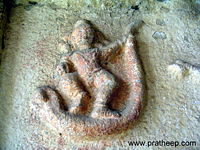
Hampi identifies with the mythological Kishkindha, the Vanara (monkey) kingdom which finds mention in the Ramayana. The first historical settlements in Hampi date to 1 C.E. Hampi formed one of the centers of the capital of the Vijayanagara Empire from 1336 to 1565. Muslim emperors destroyed it. The founders of Hampi selected the site for its strategic location, bounded by the torrential Tungabhadra river on one side and surrounded by defensible hills on the other three sides.
In terms of architecture and history, the site has immense significance. Abundant large stones had been used to create life-like statues of gods. Structure of historic importance stand every quarter of a mile. Sadly, the city stands in ruins, a testimony to the Islamic ravages of the sites. The conquerers considered the statues at Hampi idols, destroying or damaging all of them. Successive governments have been unable to protect the site from looters and treasure hunters, who cause further damage. The Archaeological Survey of India has conducted continuous excavations of the site to discover more artifacts and temples.
Geography
Hampi sits on the banks of the Tungabhadra river, 353 km from Bangalore, 254 km from Bijapur, and 74 km away from Bellary. Hospet, the nearest taluka headquarters, sits 13 km away. The majority of the people speak Kannada. Agriculture, the support of the Virupaksha temple and other holy places in the vicinity, and tourism represent the principal pillars of the village's economy. The government of Karnataka organizes the annual Vijayanagar Festival in November. Mining rich deposits of iron-ore and manganese provides work and brings money into the region. A recent increase in demand for iron-ore internationally has led to excessive mining in the district. The World Heritage Site at Hampi, as well as the Tungabhadra Dam, have been endangered by the excessive mining.
Important sites at and near Hampi
- Achyutaraya Temple/Tiruvengalanatha Temple
- Akka Tangi Gudda
- Anegondi
- Anjeyanadri Hill
- Aqueducts and Canals
- Archaeological Museum, Kamalapura
- Badava Linga
- Balakrishna Temple
- Bhima’s Gate
- Bhojanasala
- Chakratirth
- Chandrashekara temple
- Coracle crossings
- Danaik's enclosure
- Elephant Stables
- Ganagitti Temple
- Gejjala Mandapa
- Guard’s quarters
- Hampi bazaar
- Hazara Rama temple
- Hemakuta Hill
- Jain temples
- Kadale Kalu Ganesha
- Kings Audience Hall
- Kondarama Temple
- lotus mahal
- Mahanavami Dibba
- Malayavanta Raghunatha temple
- Malyavanta Hill
- Matunga Hill
- Mint
- Octagonal bath
- Octagonal Water pavilion
- Pampa Sarovar
- Pattaabhi Rama temple
- Purandaradasa mandapam
- Pushkarani or the Stepped Tank
- Rishimukh
- Royal enclosure
- Saraswati Temple
- Sasive Kalu Ganesha
- Sita Konda
- Sugriva's Cave
- The Kings’ balance
- The Underground Temple
- Tungabhadra River
- Uddana Veerabhadra temple
- Ugra Narasimha
- Virupaksha Temple
- Vittala temple
- Yeduru Basavanna
- Yentrodharaka Anjaneya temple
- Zenana enclosure
- Virupapurgadde
Virupaksha Temple
Virupaksha Temple represents the main center of pilgrimage at Hampi and has been considered sacred over many centuries. Fully intact among the surrounding ruins, devotees still use the temple for worship. The temple has been dedicated to Shiva, known here as Virupaksha, the consort of the local goddess Pampa, associated by local mythology with the Tungabhadra River.
History
The temple has an uninterrupted history from roughly the seventh century C.E. The Virupaksha-Pampa sanctuary existed well before the the Vijayanagara capital located here. Inscriptions referring to Shiva date back to the ninth and tenth centuries.[2] What started as a small shrine grew into a large complex under the Vijayanagara rulers.[3] Evidence indicates there were additions made to the temple in late Chalukyan and Hoysala periods but most of the temple buildings are attributed to the Vijayanagar period.[4]
Under the Virjayanagara rulers early in the twelfth century, native art and culture flowered. When invaders defeated those rulers in the sixteenth century, they systematically destroyed most of the magnificent decorative structures.[5] The cult of Virupaksha-Pampa survived the destruction of the city in 1565. Worship at the temple has continued throughout the centuries. At the beginning of the nineteenth century, the temple underwent major renovations and additions, including ceiling paintings and the towers of the north and east gopura.[6]
Temple structure
At present, the main temple consists of a sanctum, three ante chambers, a pillared hall and an open pillared hall. A pillared cloister, entrance gateways, courtyards, smaller shrines and other structures surround the temple.
The nine-tiered eastern gateway, the largest at 50 meters, was a well-proportioned construction, incorporating some earlier structures. It has a brick superstructure and a two-tiered stone base, giving access to the outer court containing many sub-shrines. The smaller eastern gateway leads to the inner court with its numerous smaller shrines. A narrow channel of the Tungabhadra River flows along the temple's terrace and then descends to the temple-kitchen and out through the outer court.
Krishnadevaraya, one of the famous kings of the Vijayanagara Empire, had been a major patron of this temple. Many believe that he commissioned the most ornate of all structures in the temple, the central pillared hall. Likewise the gateway tower giving access to the inner courtyard of the temple. Inscriptions on a stone plaque installed next to the pillared hall cite his contribution to the temple, recording that Krishna Devaraya commissioned the hall in 1510 C.E.[7]
Festivals
The temple continues to prosper and attracts huge crowds for the betrothal and marriage festivities of Virupaksha and Pampa in December. In the month of February, the annual chariot festival celebrated here draws enormous crowds.
Pictures
Notes
- ↑ UNESCO, Group of Monuments at Hampi. Retrieved December 20, 2006.
- ↑ University of Pennsylvania, Virupaksha Research Project. Retrieved September 13, 2006.
- ↑ hampionline, Shri Virupaksha Temple. Retrieved September 13, 2006.
- ↑ Hotel Skarnataka, Virupaksha Temple.
- ↑ Templenet.com, Virupaksha Temple at Hampi. Retrieved September 13, 2006.
- ↑ University of Pennsylvania, Virupaksha Research Project. Retrieved September 13, 2006.
- ↑ Hampi.in, Details of Virupaksha Temple. Retrieved March 8, 2007.
ReferencesISBN links support NWE through referral fees
- Fritz, J.M., et. al. New Light on Hampi: Recent Research at Vijayanagara. Marg Publications, 2001. ISBN 818502653X
- Longhurst, A.N. Hampi Ruins Described and Illustrated. Laurier Books Ltd., 2002 (original 1998). ISBN 8120601599
- The Ruins of Hampi: Travel Guide. ASIN B079KHXH6W
- Satyan, T.S. Hampi: The fabled capital of the Vijayanagara Empire. Govt. of Karnataka, 1995.
External links
All links retrieved January 21, 2024.
- Group of Monuments at Hampi - UNESCO page.
- Karnataka.com - hampi.
- A Guide to History and Tourism at Hampi.
- A website dedicated to info on Hampi.
- Virupaksha Temple at Hampi.
| ||||||||||||||||||||||||||
| |||||||
Credits
New World Encyclopedia writers and editors rewrote and completed the Wikipedia article in accordance with New World Encyclopedia standards. This article abides by terms of the Creative Commons CC-by-sa 3.0 License (CC-by-sa), which may be used and disseminated with proper attribution. Credit is due under the terms of this license that can reference both the New World Encyclopedia contributors and the selfless volunteer contributors of the Wikimedia Foundation. To cite this article click here for a list of acceptable citing formats.The history of earlier contributions by wikipedians is accessible to researchers here:
The history of this article since it was imported to New World Encyclopedia:
Note: Some restrictions may apply to use of individual images which are separately licensed.
